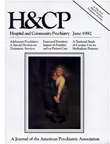Recognition of Alcohol Abuse in Psychiatric Outpatients and Its Effect on Treatment
Abstract
Previous studies of detection of alcoholism by primary medical care-givers have found discovery rates to be at best 50 percent (2-6). In this study, mental health clinicians-in-training recognized alcohol-related symptoms in almost 70 percent of patients. However, alcohol abuse was unrecognized in nearly a third of patients identified as probable alcohol abusers.
Significant differences between therapists' ratings of the success of treatment of alcohol abusers and the success of treatment of nonabusers were found. Patients in whom alcohol abuse was recognized tended to be rated as more enjoyable to work with and as having a more successful treatment than patients whose alcohol problems were unrecognized, although this difference was not significant. This trend is consistent with clinical impressions that clinicians' failure to recognize patients' alcohol-related symptoms may produce miscommunication that can result in the clinicians' experiencing a sense of frustration and futility and the patients' experiencing a sense of being less well understood.
The short form of the MAST, although less sensitive than the trainees' judgments, was quite accurate in predicting which patients were alcohol abusers. Our experience indicates that brief screening scales like the MAST could be valuable and easily administered adjuncts to the evaluation of general psychiatric outpatient populations. Routine use of such scales might reduce the frequency of nonrecognition of a variety of substance abuse problems as well as raise the consciousness of providers working in settings that do not offer specialized substance abuse treatment services.
Access content
To read the fulltext, please use one of the options below to sign in or purchase access.- Personal login
- Institutional Login
- Sign in via OpenAthens
- Register for access
-
Please login/register if you wish to pair your device and check access availability.
Not a subscriber?
PsychiatryOnline subscription options offer access to the DSM-5 library, books, journals, CME, and patient resources. This all-in-one virtual library provides psychiatrists and mental health professionals with key resources for diagnosis, treatment, research, and professional development.
Need more help? PsychiatryOnline Customer Service may be reached by emailing [email protected] or by calling 800-368-5777 (in the U.S.) or 703-907-7322 (outside the U.S.).



